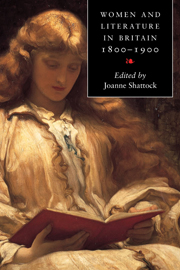Book contents
- Frontmatter
- Contents
- List of contributors
- Acknowledgments
- Chronology
- Introduction
- 1 The construction of the woman writer
- 2 Remaking the canon
- 3 Women and the consumption of print
- 4 Women writing woman: nineteenth-century representations of gender and sexuality
- 5 Feminism, journalism and public debate
- 6 Women's writing and the domestic sphere
- 7 Women, fiction and the marketplace
- 8 Women poets and the challenge of genre
- 9 Women and the theatre
- 10 Women writers and self-writing
- 11 The professionalization of women's writing: extending the canon
- 12 Women writers and religion
- 13 Women writing for children
- Guide to further reading
- Index
1 - The construction of the woman writer
Published online by Cambridge University Press: 03 October 2009
- Frontmatter
- Contents
- List of contributors
- Acknowledgments
- Chronology
- Introduction
- 1 The construction of the woman writer
- 2 Remaking the canon
- 3 Women and the consumption of print
- 4 Women writing woman: nineteenth-century representations of gender and sexuality
- 5 Feminism, journalism and public debate
- 6 Women's writing and the domestic sphere
- 7 Women, fiction and the marketplace
- 8 Women poets and the challenge of genre
- 9 Women and the theatre
- 10 Women writers and self-writing
- 11 The professionalization of women's writing: extending the canon
- 12 Women writers and religion
- 13 Women writing for children
- Guide to further reading
- Index
Summary
‘A woman and her book are identical’ – or so Edgar Allen Poe reflected when reading an early collection of poems by Elizabeth Barrett Browning. Remembering the autobiographical nature of much of Barrett Browning's early work, his comment is not surprising. But it has a more general relevance for nineteenth-century women writers. The charge that they could only write of what they knew, and that what they knew best was themselves, was made regularly by reviewers. The easy association of the life and the work, or, more accurately, a refusal to separate them, was crucial to the reading of these writers by their contemporaries. In this chapter I am concerned with the reading of Victorian women, how they were read in the nineteenth century, particularly how they read one another, and how we read them today. More specifically I am interested in the role that contemporary biography played in this process: how, in a number of celebrated instances, a biography constructed the woman writer inherited by the next generation of writers and readers of both sexes.
It was the feminist critic Ellen Moers who first made the point that nineteenth-century English women writers sought and created the sense of a literary community by reading one another's books. ‘The personal give-and-take of the literary life was closed to them’, she wrote, ‘Without it they studied with a special closeness the works written by their own sex, and developed a sense of easy, almost rude familiarity with the women who wrote them.’
- Type
- Chapter
- Information
- Women and Literature in Britain 1800–1900 , pp. 8 - 34Publisher: Cambridge University PressPrint publication year: 2001
- 7
- Cited by



